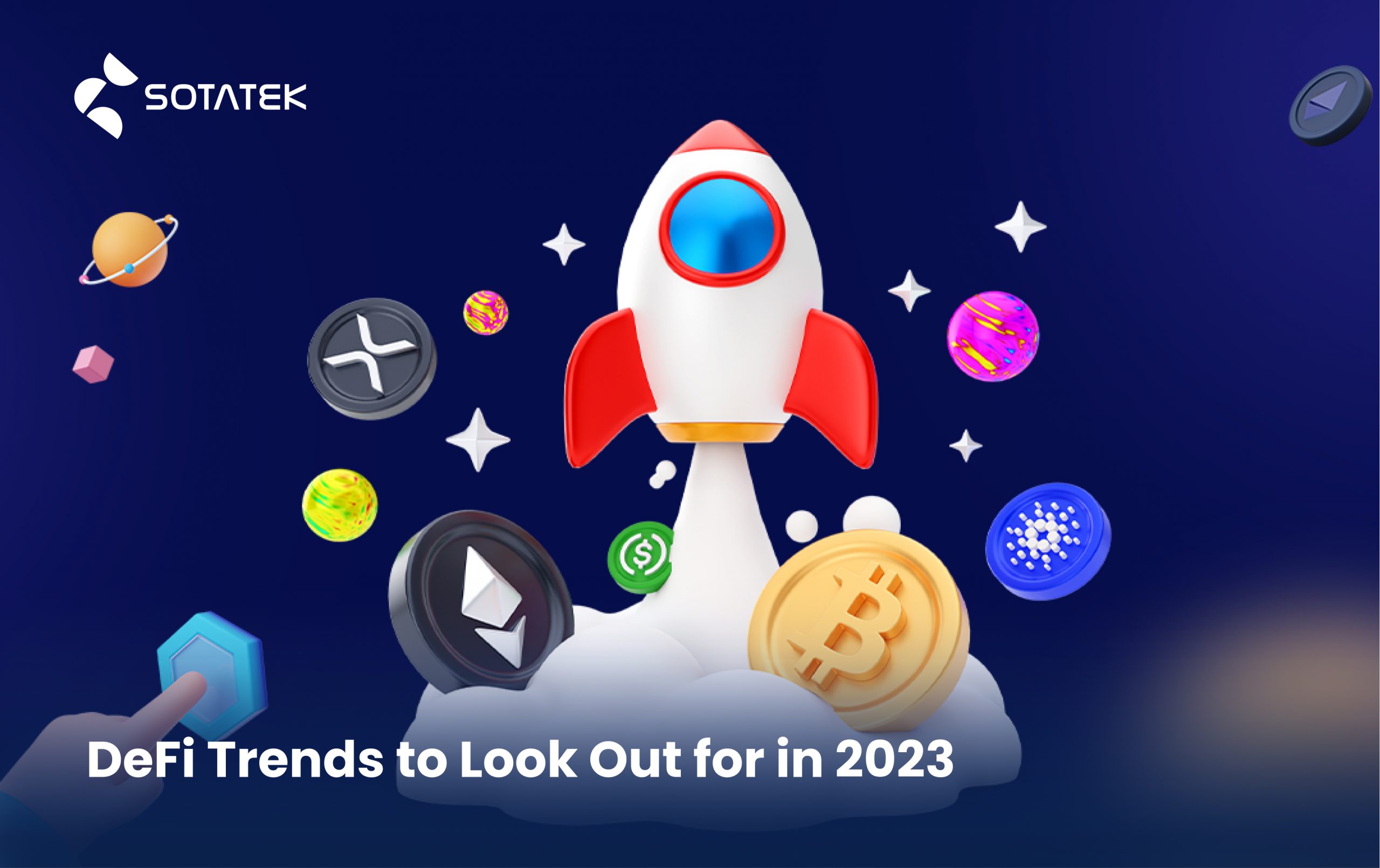The Blockchain sector bloomed last year and the world has witnessed the emergence of Blockchain applications such as NFT, Decentralized Finance, Metaverse, Cryptocurrency and more. Decentralized Finance (DeFi) is one of the most sought-after demands with an expected $231.19 billion market value by 2023. These DeFi applications and services offer a transparent financial approach, which allows users to exchange, buy, lend and borrow cryptos without the interference of traditional institutions. There will be more rooms to discover for DeFi and let’s reveal what DeFi trends await in 2023.
1. What is DeFi?
Decentralize Finance (DeFi) is a Blockchain fintech solution allowing financial transactions without the involvement of traditional institutions such as banks and financial corporations.
Users can purchase and sell tokens and cryptocurrency without banks and brokers as the DeFi system will connect buyers, sellers, and traders with peers or middlemen by using hack-proof software. Users are not required to show any identity proof like Government ID or social security number. By using DeFi, the service charge for transactions is lifted, bringing down the cost for users. Some other advantages of DeFi include transparency, advanced securities, and better integration.
Read more: Which Is Better For DeFi Projects: Ethereum or Solana?
2. DeFi Trends to Watch in 2023
a. Blockchain Technology Development
The development of Blockchain will increase the efficiency of digital transactions with better securities and transparency. New technologies such as Zero-Knowledge Proofs will enhance the experience for users, simplifying and improving data securities in payments and smart contracts.

Zero-knowledge proof, a highlight technology to secure smart contracts
b. Cross-chain Technology
The blockchain ecosystem unfortunately limits the communication between two non-native blockchain networks. Also, the second generation of Blockchain beginning with Etherium created many challenges such as high transaction costs, slow transaction execution and lack of liquidity. To address this matter, cross-chain technology arises to enable interoperability across independent blockchains, allowing interactions and data transfer. The cross-chain DeFi technology allows multi-chain smart contract transactions and connects independent Defi Platform, marketplace and dApps to support a sufficient and low-cost DeFi economy.
c. Decentralized Finance in Gaming
Crypto gaming introduces a new form of investment in the traditional gaming platform with the Play-to-Earn (P2E) industry. The idea of merging DeFi, NFTs with blockchain-based games has created a promising ecosystem for the cryptocurrency market. Users are now able to mine cryptocurrency, NFTs and other assets via their gaming activities.
The DeFi protocols can enable users to commercialize blockchain games and secure in-game transferability in the gaming industry.
d. Liquidity Mining and Staking
One of the most anticipated trends in DeFi is liquidity mining or yield farming. Liquidity mining is a process in which crypto holders lend assets and tokens to a Decentralized Exchange in return for rewards. Staking is also a method of generating rewards with cryptocurrency holdings by holding the cryptos on the platform. The rewards can be service charges or new cryptocurrency tokens. This opens up a new opportunity for both the Decentralized Exchange and users to profit from the cryptocurrency holdings.
e. Governance Tokens
Governance tokens are types of cryptocurrency that allow individuals to vote on blockchain project development and management matters. Most decentralized finance (DeFi) tokens are governance tokens, voting is not the only feature as holders of governance tokens can use them to take out loans, and stake and earn money through yield farming.
Governance tokens are still a new invention, so there are still debates surrounding them. 2023 might be the year to watch out for these tokens to rise.
f. Metaverse
Soon we will see the emergence of new virtual social networks where the new economy of social tokens in the metaverse can change the whole digital monetization scenario. Creators and brands can monetize through social tokens and financial benefits. DeFi protocols are now the key features to enable and support the transactions between artists and customers in the metaverse.
Read more: Catch Up With The Growing Trend: Metaverse
g. NFT Platform
Non-Fungible Tokens (NFTs), along with DeFi, are the two most popular applications of the blockchain domain. Non-fungible tokens focus on the tokenization of digital assets while DeFi offers decentralized access to financial services. There exists a possibility of leveraging the combination of NFT DeFi for greater benefit.
With the ability of proof ownerships, NFTs can help resolve the problem of collateralization and open up a new space for NFT holders to obtain loans with NFTs as collateral. NFT-backed loans are getting the attention and soon will become a prominent feature in DeFi.

The example of NFTs as collateral
3. Conclusion
Blockchain, one of the most accessible technologies today, delivers transparency, high security and data integrity. DeFi will undoubtedly reach new heights in the fintech industry with the advancement of NFTs, cryptocurrency and other blockchain services and applications.



